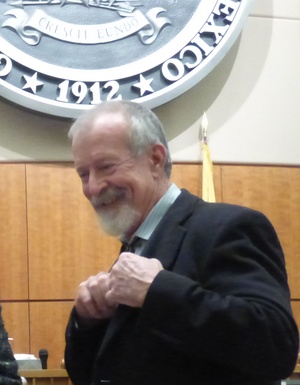Environmentalists charge violations of New Mexico open meetings and records laws in plan to divert Gila River

A former official with a New Mexico water commission is accusing his old organization of violating the state’s open meeting laws. With at least $34 million in federal funding and the future of a controversial water diversionary project with the Gila River in question, the stakes are huge.
New Mexico District Judge Raymond Ortiz has ordered a Wednesday hearing on charges by Norman Guame, former staff director for the New Mexico Interstate Stream Commission (ISC), that a ISC subcommittee had held crucial decision making meetings in secret. Ortiz had earlier issued a temporary restraining order preventing the commission from taking any action on the Gila River based on Guame’s allegations. After next week’s hearing, he’ll decide whether the ISC is in violation of open meetings laws.
At issue is a project to divert many thousands of acres of water from the river, a tributary of the Colorado River that flows through southwestern New Mexico and Arizona. The project has pitted environmentalists against ranchers who want more access to water.
In 2004, Congress passed the Arizona Water Settlements Act, which settled decades-long litigation over water rights with Native American tribes in the region. As part of the agreement, New Mexico got $66 million to fund projects that meet water demands. The state is eligible for a subsidy of an additional $34 million to $62 million if it decides to take up to an additional 14,000 acre-feet of water from the Gila River system.
Environmentalists favor an approach based on conservation instead. They argue that developing a plan for more efficient water conservation in the region would be not just environmentally sound, but also make fiscal sense. Despite the federal subsidy, New Mexico taxpayers would be on the hook for the full costs of the project, opponents say. Guame estimates the price tag could exceed $1 billion.
The state loses its chance to obtain the additional federal funds if it doesn’t submit a formal request to the U.S. Department of the Interior by Dec. 31.
Guame’s open meeting complaint argues that a “Gila Subcommittee,” formed in 2010 by the water commission’s chairman to consider options for the future of the river, has held its meetings in secret. During these meetings, the subcommittee approved at least two contracts with outside consultants to produce evaluations of potential projects. Because the subcommittee will be making recommendations to the full commission on diversionary projects for the river, Gaume argues that it is violating open meetings rules that “the formation of public policy or the conduct of business by vote shall not be conducted in a closed meeting.”
In an official statement, the commission asserts that the Gila Subcommittee “is merely advisory in nature” and therefore is not subject to the Open Meetings Act. “Mr. Norm Gaume’s allegations of violations by the Interstate Stream Commission of the Open Meetings Act are nothing more than a show to cast aspersions on the Commission’s public process to consider projects under the federal Arizona Water Settlements Act,” the statement said.
Commission would not provide data
Before filing the open meetings complaint in September, Guame, an engineer, had already been frustrated in his attempts to obtain electronic copies of the data used by the commission on water flows in the Gila River, which he requested under the state’s Inspection of Public Records Act so he could conduct an independent analysis. The water flow data is crucial to understanding how the river will be affected by projects to divert water.
But Guame’s request on Feb. 3 for an “unlocked copy of [the Commission’s] Excel spreadsheet model of divertable Gila River flows” was denied two days later by the ISC, which claimed the spreadsheet model “constitutes a database,” and New Mexico law says agencies have “discretion to provide or withhold a database.”
Later that month, ISC Director Estevan Lopez — and President Barack Obama’s pick to be the next commissioner of the U.S. Bureau of Reclamation — told a New Mexico state Senate committee that the commission had the legal authority to withhold the database under the Public Records Act, a separate law from New Mexico’s Inspection of Public Records Act: “[W]e can condition its release to make sure it’s not used for commercial or political purpose. I’d argue that given the context in which it was requested, that is in preparation for this [hearing], I don’t see that it was going to be used for anything but a political purpose.”
The quote is in a recording provided to Sunlight by Susan Boe, executive director of the New Mexico Foundation for Open Government.
“How can we intelligently discuss public policy without first having access to the facts?” says Boe. “We may disagree about what those facts mean, but at least we are all looking at the same facts … If we cannot speak out against public officials, of what use is the First Amendment? No transparency, no democracy.”
The hearing was in the context of proposed legislation, SB 89 by Sen. Peter Wirth, a Democrat, which would have required the ISC to use a chunk of federal money to consider alternatives for diverting the river. That bill died in the 2014 session.
Guame eventually did get his data in February — through a mistake. The ISC inadvertently gave him a version along with some other documents. Even so, the commission continued to maintain its stance against an official release of the data. In April, Lopez wrote Gaume an email stating: “My answer remains unchanged. We will not make the model available to you.”

